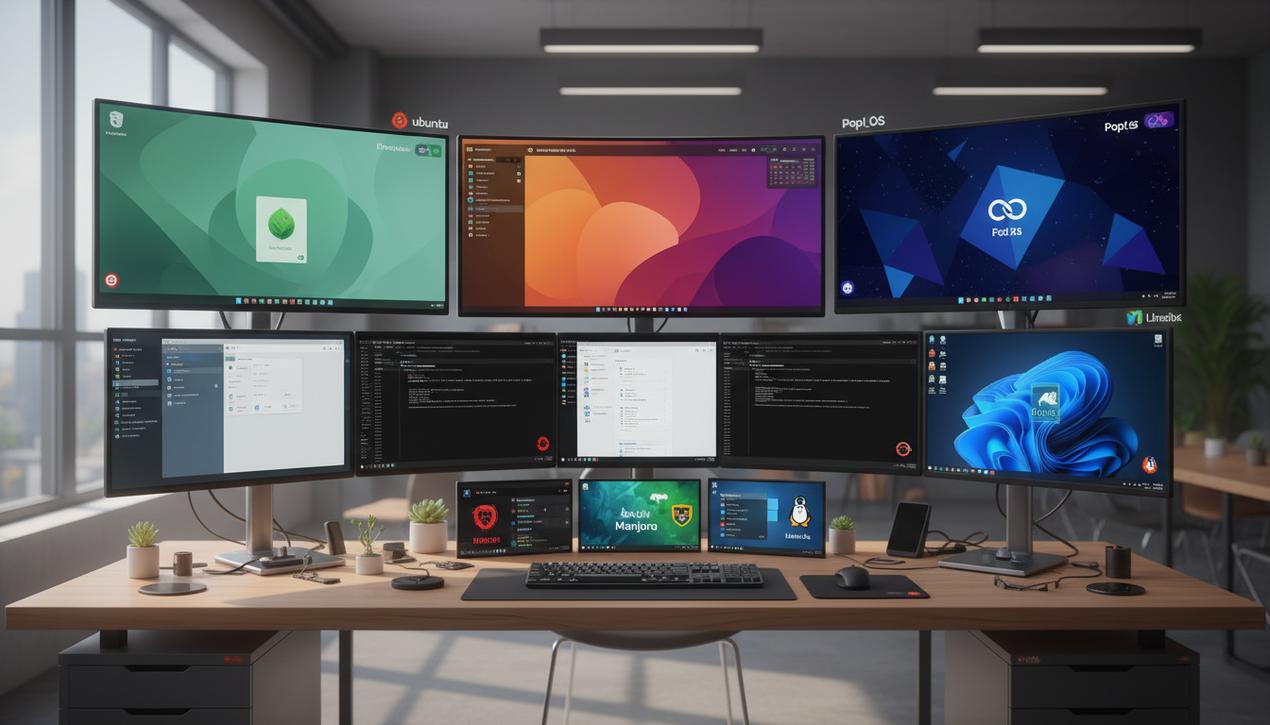Best Linux Distros: The Ultimate 2025 Guide


In the vast world of operating systems, Linux holds a unique and dominant position. Far from a monolithic entity, it exists as hundreds of versions known as “distributions,” each with its own philosophy, toolset, and target audience. In 2025, Linux powers over 96% of the world’s top one million web servers and forms the core of the Android ecosystem, showcasing its unparalleled robustness and flexibility. For desktop users, the choice of a Linux distribution has never been more relevant, with its market share recently surpassing a historic 4% milestone. This surge is partly fueled by gaming advancements like Valve’s Steam Deck, offering a powerful, secure, and often free alternative to proprietary operating systems. Whether you’re a seasoned developer learning how to create a mobile app, a creative professional seeking a macOS alternative, or a curious beginner ready to explore a new digital environment, there’s a Linux distribution built for you.
This comprehensive guide explores the most essential Linux distributions of 2025. We’ll go beyond a simple list to analyze the strengths and weaknesses of each option, categorizing them by use case and skill level. From accessible giants like Ubuntu and Linux Mint to expert-level platforms like Arch Linux, and including specialized options for gaming and security, we’ll provide all the key information you need to make an informed choice and find the operating system that perfectly matches your needs and ambitions.
How to Choose the Right Linux Distribution
Before diving into our selection, it’s crucial to understand the criteria that differentiate one distribution from another. The right choice depends entirely on your goals, your hardware, and your technical comfort level. Here are the key factors to consider in 2025.
1. Desktop Environment (DE)
The desktop environment is the graphical interface you interact with. It defines the look, feel, and overall user experience. The most popular choices include:
- GNOME: Modern, minimalist, and workflow-oriented.
- KDE Plasma: Highly customizable, feature-rich, and visually polished.
- Cinnamon: Traditional, intuitive, and very familiar for former Windows users.
- XFCE: Lightweight and fast, making it ideal for older hardware.
2. Target Audience and Skill Level
Every distro has a target user in mind. Some, like Ubuntu, are designed to be as simple as possible to welcome beginners. Others, like Arch Linux, cater to advanced users who want to build a custom system from the ground up, controlling every single installed package. Your experience level is a critical deciding factor.
3. Release Model: Fixed vs. Rolling
There are two primary release models:
- Fixed Release: Major versions are released at regular intervals (e.g., every six months for Ubuntu). This model is predictable and extremely stable, making it ideal for production environments.
- Rolling Release: Updates are delivered continuously as soon as they are ready. This means you always have the latest software but with a slightly higher potential for instability. Arch Linux and Manjaro are prime examples.
4. Package Manager
This is the tool that allows you to install, update, and remove software. Debian-based systems (like Ubuntu) use APT (`.deb` files), while Red Hat-based systems (like Fedora) use DNF (`.rpm` files). Arch Linux uses Pacman. While software availability can sometimes vary, universal formats like Flatpak and Snap are making it easier to run any app on any distro.
Best Linux Distributions for Beginners
These distributions are perfect for a first foray into the Linux world. They prioritize simplicity, stability, and a user-friendly, out-of-the-box experience.
Ubuntu
Undoubtedly the most famous desktop Linux distribution, Ubuntu is the entry point for millions of users. Based on Debian and developed by Canonical, it stands out for its ease of installation and use. Its graphical installer is one of the simplest on the market, and hardware detection is generally excellent. Ubuntu uses a customized, accessible version of the GNOME desktop environment. Its vast community ensures that you can find help for almost any issue imaginable.
Linux Mint
Often recommended as the best alternative to Ubuntu for beginners, Linux Mint is built on the Ubuntu LTS (Long Term Support) version to ensure maximum stability. Its main strength is the Cinnamon desktop environment, which offers a traditional and familiar experience for users coming from Windows, complete with a taskbar, start menu, and desktop icons. It also includes multimedia codecs by default for a hassle-free media experience right from the start.
Pop!_OS
Developed by computer manufacturer System76, Pop!_OS is based on Ubuntu but optimized for developers, creators, and STEM professionals. It offers a specific version with NVIDIA drivers pre-installed, making it a top-tier choice for gamers and anyone with an NVIDIA GPU. Its modified GNOME interface, Cosmic, includes an automatic window tiling feature that significantly boosts productivity.
Zorin OS
Zorin OS is arguably one of the most polished and user-friendly distributions available, designed specifically to ease the transition for Windows and macOS users. It features a unique application that allows you to change the desktop layout to mimic familiar interfaces with a single click. It comes packed with all the essential software and offers a “Lite” version using XFCE for older computers, ensuring excellent performance on any hardware.
Elementary OS
If you’re a fan of macOS’s design aesthetic, Elementary OS is for you. Based on Ubuntu, this distribution focuses on a clean, coherent, and elegant design with its custom Pantheon desktop environment. It offers its own ecosystem of applications designed to integrate perfectly with the interface, creating a highly curated user experience. The emphasis is on simplicity and minimizing the need for the command line.
Top Choices for Advanced Users and Developers
For those who already have Linux experience or desire complete control over their system, these distributions offer power, flexibility, and deep customization.
Debian
Founded in 1993, Debian is one of the oldest and most respected distributions. It is known as “The Universal Operating System” and serves as the foundation for countless others, including Ubuntu. Its reputation is built on legendary stability, making it a top choice for servers. By default, it includes only free and open-source software, though access to proprietary drivers and packages is still possible.
Fedora
Backed by Red Hat (an IBM subsidiary), Fedora is a cutting-edge distribution that integrates the latest open-source technologies, such as the Wayland display server and the Btrfs filesystem by default. Its rapid development cycle (a new version every six months) ensures access to the very latest software. It’s an excellent choice for developers who want a preview of the future of the Linux ecosystem and serves as the upstream for Red Hat Enterprise Linux (RHEL).
Arch Linux
Arch Linux embodies the “Keep It Simple, Stupid” (KISS) philosophy. It’s a minimalist, rolling-release distribution that provides the tools for you to build your system from the ground up. The installation is done entirely via the command line, which can be daunting, but the result is a system perfectly tailored to your needs with no unnecessary software. Its Wiki is widely regarded as the best documentation in the Linux ecosystem, an invaluable resource even for users of other distros. The Arch User Repository (AUR) provides access to a massive library of community-packaged software.
Specialized Distros for Specific Needs
Beyond general-purpose computing, some distributions are optimized for very specific tasks, from cybersecurity to modern gaming.
Kali Linux
Based on Debian, Kali Linux is the industry standard for cybersecurity professionals and penetration testers. It comes pre-installed with hundreds of specialized tools for network analysis, reverse engineering, password cracking, and vulnerability analysis. This is not a distribution for daily use, but a powerful toolkit for experts performing an information system audit.
Nobara Project
For gamers and content creators, the Nobara Project is a game-changer. It’s a modified version of Fedora with user-friendly fixes and optimizations applied out of the box. Maintained by a prominent developer from the Wine/Proton community, it includes GPU drivers, gaming-focused kernel patches, and software dependencies needed for a seamless gaming experience on platforms like Steam and Lutris. It saves users hours of manual configuration.
Manjaro
For those attracted to the power of Arch Linux but put off by its complex installation, Manjaro is the perfect solution. It offers all the benefits of Arch (rolling release, access to the AUR) but with a simple graphical installer and a pre-configured, ready-to-use system. It allows you to choose your preferred desktop environment during installation and automatically manages drivers for a much smoother experience.
Choosing a Linux distribution is a personal journey, and the best approach is experimentation. Thanks to virtual machines (like VirtualBox) or “Live USBs,” you can test most of these systems without installing anything on your hard drive. Whether you seek the simplicity of Ubuntu, the rock-solid stability of Debian, or the total control of Arch, the Linux ecosystem in 2025 offers a mature, powerful, and adaptable solution for every need.




